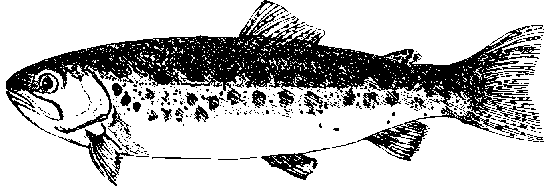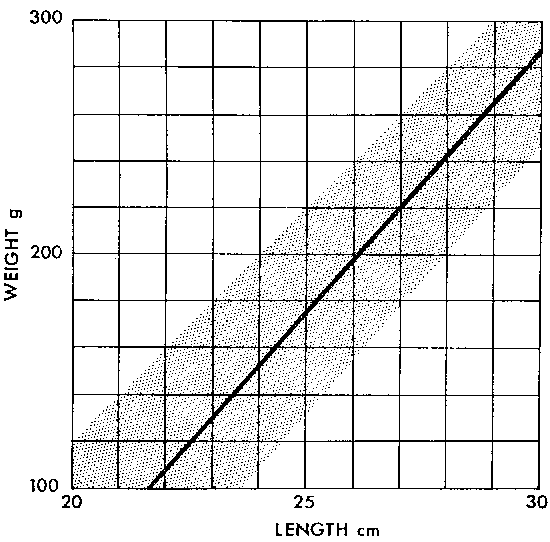Introduction
Scientific names
Common names
Distinguishing features
Distribution
Size and weight
Chemical composition
Handling fresh trout
Frozen trout
Smoked trout
This note gives advice on the handling and preparation of chilled and frozen rainbow trout, and describes the manufacture of hot smoked trout.
The advice on processing is preceded by a brief description of the fish, its growth and distribution, and the rearing of farmed trout for the table.
Previously rainbow trout was referred to as Salmo gairdneri, or sometimes as Salmo irideus, but the correct name is now Oncorhynchus mykiss.
The rainbow trout is often referred to as finger trout or simply as trout. In North America the migratory variety of the species is usually called steelhead trout or simply steelhead. Varieties of distinctive appearance resulting from adaptation to a particular locality are sometimes given regional names, for example Kamloops trout in British Columbia.
|
|
|
Foreign names |
|
|
Czech |
pstruha, duhového |
Japanese |
nijimasu |
|
Danish |
regnbueørred |
Norwegian |
regnbueaure, regnbueørret |
|
Dutch |
regenboogforel |
Polish |
pstragów txxxeczowych |
|
French |
truite arc-en-ciel |
Portuguese |
truta-arco-iris |
|
German |
Regenbogen forelle |
Romanian |
pãstrãvul curcubeu |
|
Greek |
pestropha |
Russian |
radoozhnoy foreli |
|
Hungarian |
szivãrvãnyos pisztrãng |
Spanish |
trucha arco iris |
|
Icelandic |
regnboga-silungur |
Swedish |
stalhuvudoring, regnbagsforell |
|
Italian |
trota iridea |
Yugoslav |
duzicasta pastrva |
The colour of the rounded body is variable, but the upper part is predominantly olive green, with many rounded dark spots on the body, head and fins; the spots on the tail fin, unlike those on the native brown trout, Salmo trutta, extend to the extreme edge. There is an iridescent band of colour, mainly pink, along the lateral line, and the lower part of the body is silver. The reddish spots that are always present on the body of the native trout are absent in the rainbow trout.
FIG. 1: Rainbow trout

The mouth is large and set obliquely, with well developed teeth in the jaws, on the palate and in the throat. The rear of the upper jaw is in line with the rear edge of the eye. The skin, covered with very small scales and slime, feels smooth.
Migratory forms of rainbow trout are generally slimmer than nonmigratory forms.
The rainbow trout is native to the rivers of north west America, but has been introduced to all continents. It occasionally lives wild in Europe in modest numbers, but is principally stocked artificially, often in landlocked waters or in manmade pond farms. Most trout farms in the UK import disease-free eggs, principally from Denmark, hatch (hem in indoor tanks, and move the fingerlings to outdoor ponds with running water, where they are reared on pellet food until they reach marketable size.
Rainbow trout grow and put on weight more quickly than other species of trout, and are thus particularly suitable for fish farming. The demand in the UK market is mainly for trout 150-300 g in weight, equivalent to a length of 24-30 cm, a size that can be achieved in 1 1/2-2 years. Rainbow trout can grow to a length of 50 cm during the third year, but there are few outlets for fish of this size. Weights in excess of 23 kg for non-migratory fish and 16 kg for migratory fish are on record for rainbow trout in the wild. The typical relationship between length and weight of farmed rainbow trout in the UK is shown in Figure 2.
The chemical composition of the raw flesh of rainbow trout is water 70-80 per cent, fat 0-7-8-3 per cent, and protein 18-20 per cent; fat and water content vary with season and with diet.
FIG. 2: Length-weight ratio of rainbow trout

Rainbow trout should preferably be starved before slaughter. The newly caught fish should be gutted, washed and packed in ice to keep them in good condition. Gutting can be done by hand or by machine, and it is preferable to remove the gills at the same time in order to reduce bacterial contamination. Trout that have been left ungutted long enough to become stiff after death are often difficult to gut by machine; they should be processed before the onset of rigor. The head should be left on because beheaded fish keep less well, and because the customer is often reluctant to accept headless trout. Blood remaining in the blood vessel along the backbone after gutting should be scraped or brushed away before the fish are thoroughly washed and packed in ice.
Gutted rainbow trout packed in ice keep in first class condition for 1 week and remain acceptable for 2 weeks; the shelf life of ungutted fish is much shorter, and chilled storage of ungutted trout cannot be recommended. Stale trout can be recognised by their sunken eyes, loss of colour and bloom from the skin, and the accumulation of yellow slime on skin and gills.
Rainbow trout, like most fish, can be kept in good condition for a long period by freezing them and holding them in a cold store. Only good quality fish should be used, and they should be washed and frozen quickly. Gutting may not be necessary prior to freezing if the fish have been starved before capture; the uncut frozen fish may be less prone to rancidity. Trout should be frozen in a properly designed freezer, not in a cold store. Because the fat content can be much higher than in lean fish like cod, trout need greater protection against the onset of rancidity in cold storage; polyethylene sleeving for individual fish and waxed cardboard containers are generally effective in reducing drying and oxidation of the frozen product. The approximate shelf life of wrapped frozen trout in a good commercial cold store is as follows:
|
|
Shelf life in months |
|
|
store temperature |
first class condition |
acceptable |
|
°C |
|
|
|
-10 |
1 |
2 |
|
-20 |
5 |
18 |
|
-30 |
8 |
over 18 |
The most common form of presentation is as hot smoked, whole gutted trout, which are cooked enough during the hot smoking process to be ready for eating without further preparation. It is therefore important that the nature of the product and the storage conditions are such that food poisoning bacteria, particularly Clostridium botulinum, cannot grow; in particular, a salt concentration of 3 per cent and a storage temperature of less than 10°C are sufficient for this purpose. By salt concentration is meant the percentage of salt in the water contained in the fish. This should be distinguished from the salt content, which is the percentage of salt in the whole weight of the fish, that is water plus protein plus fat. This level of salt is acceptable to the taste of most people. More detailed advice on prevention of botulism is given in Advisory Note 22.
Brining
Newly harvested rainbow trout should be kept in ice for at least 1 day after gutting; otherwise they may take up insufficient salt during brining. Frozen trout can be brined immediately after thawing.
The fish should be washed and carefully graded by weight before brining, so that the uptake of salt is uniform throughout a batch in a given time. Suitable brining times in 80° brine, that is 28 g salt to 100 g water, are as follows:
|
Weight of trout |
Brining time |
|
g |
h |
|
140 |
2 |
|
170 |
2 ½ |
|
200 |
3 |
|
250 |
4 |
|
300 |
5 |
The brined fish are threaded on speats, through either the eyes or tail, and are hung to allow surplus brine to drain from the fish.
The adequacy of the brining process should be confirmed from time to time by analysing the salt concentration in samples of smoked trout. A sample should be taken 1 day after smoking. Flesh should be taken from the thickest part of a fish, half way between head and tail and just above the backbone, where salt content is likely to be least. The salt content, measured as g salt/100 g flesh, is used to determine the salt concentration as follows:

Where the salt concentration is found to be below the prescribed minimum of 3 per cent, the brining process should be revised to increase it. Firms unable to make such an analysis for themselves should use the services of a competent analyst.
Smoking
The following sequence is suitable for the hot smoking of trout in a mechanical kiln. After loading the speats of fish into the kiln, the smoke temperature is raised slowly to 30°C and held at that temperature for at least 1/2 hour, to allow the skin of the fish to dry and toughen sufficiently to support the weight of the fish during the later stages of smoking. The air inlet and outlet are then almost closed to raise the kiln temperature quickly and to increase humidity so that the product is not dried too much. The smoke temperature is then raised to 50°C and maintained at that for 1/2 hour, and finally to 80°C for 3/4 hour to 1 hour until the fish are cooked.
Yield
Weight losses at each stage in the preparation of smoked trout are approximately 10 per cent during gutting, 6 per cent during brining and 16 per cent during smoking to give a yield of about 71 per cent of the weight of the whole fish.
Packing
The smoked fish should be allowed to cool, at least to below 10°C and preferably to below 4°C by holding them in a chillroom, before they are packed. Care should be taken to prevent bacterial contamination of the product during packing, by keeping it off worktops or other surfaces as much as possible. All work surfaces should be kept scrupulously clean. The packing area should be kept separate from the raw material processing area to avoid cross contamination.
Storage
Hot smoked trout, prepared by the method described and kept in a chill below 4°C, will keep in good condition for 1 week. At a temperature of 5-10°C they will remain wholesome and safe to eat for 2-3 days. Smoked trout should always be kept chilled or frozen throughout the distribution chain. Frozen smoked trout, properly wrapped, will keep in good condition for 12 months in cold storage at -30°C.
If-you have any queries, write, phone or call at either of the addresses given below:
|
The Director |
The Officer in Charge |
|
Torry Research Station |
Humber Laboratory |
|
PO Box 31 |
Wassand Street |
|
135 Abbey Road |
Hull |
|
Aberdeen |
HU3 4AR |
|
AB9 8DG |
|
|
Tel: 0224 87707 |
Tel: 0482 27879 |
61 Gaping of fillets, by R. M. LOVE.
62 The freezing time of fish, by F. J. NICHOLSON.
63 Fishing ports in the UK, by J. J. WATERMAN.
64 Fish silage, by I. TATTERSON and M. L. WINDSOR.
65 Fishworking machinery, by S. Mair.
66 Handling and processing mackerel, by J. N. KEAY.
67 The haddock, by J. J. WATERMAN.
68 Icemaking plant, -by J, GRAHAM.
69 Cook-freeze fish products, by J. N. KEAY.
70 Advice for the fish industry; who does what, by J. J.
WATERMAN.
71 Processing cod; the influence of season and fishing ground,
by R. M. LOVE.
72 Reducing odour in fish meal production.
73 Stowage of fish in chilled sea water, by J. H.
KELMAN.
Earlier notes in the series, most of which are still available, are summarized in
60 Key to Advisory Notes 1-59, by J. J. WATERMAN.
Crown Copyright Reserved